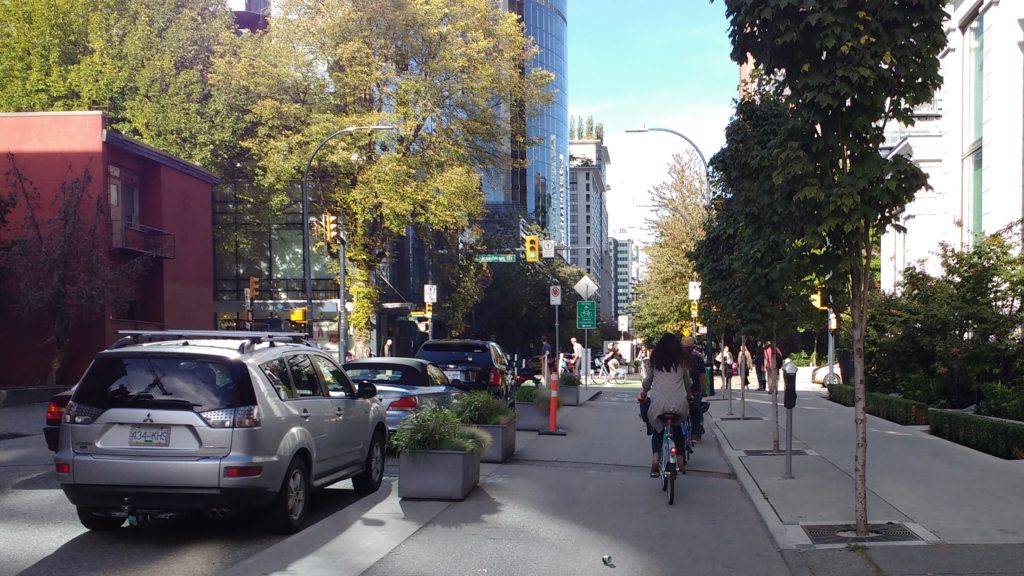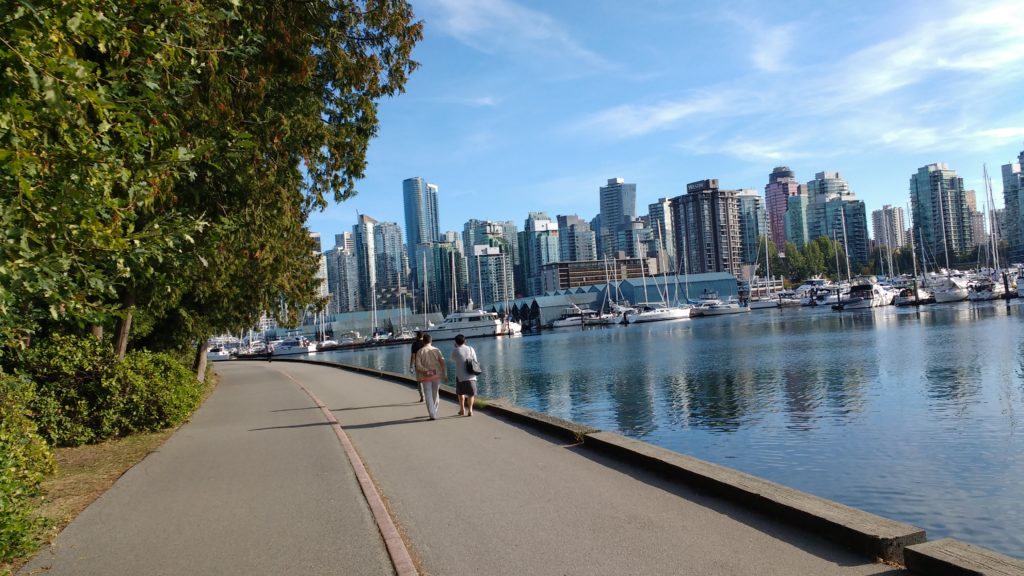Bjorn's Bike Advocacy Field Notes: Designing Bike Routes for All Ages and Abilities in Vancouver
MCBC’s Policy and Planning Director recently travelled to Vancouver, British Columbia for the Pro Walk Pro Bike Pro Place Conference. Here, he shares lessons learned from his time exploring the city on two wheels.
When visiting a new city, one of my favorite things to do is hop off at a random transit stop without an agenda and embark upon a meandering walk or bike ride guided only by my curiosity and senses.
While in Vancouver, I grabbed a bike and did just that, setting off along the pathway that follows the city’s waterfront. Within minutes, I felt like a local. Green paint ushered me safely through treacherous intersections that would have given me pause in its absence. Clear signage steered me in the right direction, easily keeping me on safe bike routes. Unimpeded by confusion or a lack of directional sense, I took in the city’s profound beauty confidently and comfortably.
Unfortunately, this was somewhat of a foreign experience. I rarely feel the same sense of certainty when riding on familiar streets in the North Bay.
If You Build It, They Will Come: Vancouver’s Quick Ascent
Between 2011 and 2015, Vancouver experienced unprecedented growth in the percentage of residents who bike to work, jumping from four to ten percent. In 2015, seven percent of all trips made in Vancouver were by bike – a goal they had set to reach by 2020. Much of this success is owed to committed elected officials and city staff who are working to implement a bike network for “all ages and abilities” (AAA).
To date, Vancouver has completed a quarter of this network. They began building it just seven years ago.
The following lessons highlight the ways in which all cities – those in Marin County included – should follow Vancouver’s lead:
1) “All Ages and Abilities” Means “All Ages and Abilities”
Even in a relatively bike-friendly area like Marin County, it’s not uncommon to see bike routes that leave people biking with no option but to share the lane with people driving 30 – 40 miles per hour, or just feet away from heavy traffic with nothing more than a line of paint for protection. Vancouver certainly has some of these situations, but it does not include them in its AAA network. It’s worth noting that Vancouver’s suburban neighbor to the north, North Vancouver (population ~48,000) also has an AAA network.
Having the AAA designation sends the message that the types of bike routes to which we have become accustomed–such as conventional bike lanes or shared lanes–are doing little to entice people to get out of their cars and onto bikes. If cities truly want to create a viable alternative to driving, they need to think about designing for the least confident riders.
The AAA network is defined by separation from high traffic volumes and speeds. People biking only share the road on traffic-calmed streets (neighborhood greenways) where cars travel 30 km/h (18.6 mph) or less. On busier streets, bike lanes are physically protected from traffic by concrete strips, planter boxes, and/or parked cars.
The AAA network is made up of three types of routes:
Neighborhood Greenways
Protected Bike Lanes
Off-Street Paths
2) None of the Above Matters Without Some Guidance and Wayfinding
If you’ve read this far, you’ll remember me saying that I felt like a local while exploring on two wheels. That’s because Vancouver has done a great job anticipating all of the confusion that one might encounter when approaching and crossing tricky intersections. Signage, paint, and bike signals are employed to create legibility that guides people through the system safely and confidently. It all comes together in this picture, taken where two AAA routes intersect.
3) Off-Street Paths and Waterfronts Are Meant For Each Other
Marin County is blessed with beautiful shorelines and waterways, some of which are lined with off-street multi-use paths thanks in large part to the efforts of the San Francisco Bay Trail. Vancouver is home to the world’s longest uninterrupted waterfront path, the 17 mile Seaside Greenway. It elegantly links the parks and beaches that form a continuous greenspace around much of the city.
While riding along the Seaside Greenway, I saw an incredibly diverse group of people biking, ranging from tourists on rental bikes, to team-kit-clad cyclists doing workouts, to children heading to the beach, to commuters with panniers.
In Summary…
Vancouver was an awe-inspiring trip for someone who appreciates safe, easy-to-use bike routes like myself. Although the city’s scale is by no means a comparable case study for any Marin cities, there are important takeaways from its steadfast commitment to prioritize investments throughout a network that appeals to people of all ages and abilities. As the next generation of bicycle projects move forward in Marin County, MCBC will look for local agencies to go above and beyond the norm by designing with all potential users in mind.









